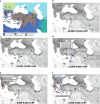Tracking the Near Eastern origins and European dispersal of the western house mouse
- PMID: 32427845
- PMCID: PMC7237409
- DOI: 10.1038/s41598-020-64939-9
Tracking the Near Eastern origins and European dispersal of the western house mouse
Abstract
The house mouse (Mus musculus) represents the extreme of globalization of invasive mammals. However, the timing and basis of its origin and early phases of dispersal remain poorly documented. To track its synanthropisation and subsequent invasive spread during the develoment of complex human societies, we analyzed 829 Mus specimens from 43 archaeological contexts in Southwestern Asia and Southeastern Europe, between 40,000 and 3,000 cal. BP, combining geometric morphometrics numerical taxonomy, ancient mitochondrial DNA and direct radiocarbon dating. We found that large late hunter-gatherer sedentary settlements in the Levant, c. 14,500 cal. BP, promoted the commensal behaviour of the house mouse, which probably led the commensal pathway to cat domestication. House mouse invasive spread was then fostered through the emergence of agriculture throughout the Near East 12,000 years ago. Stowaway transport of house mice to Cyprus can be inferred as early as 10,800 years ago. However, the house mouse invasion of Europe did not happen until the development of proto urbanism and exchange networks - 6,500 years ago in Eastern Europe and 4000 years ago in Southern Europe - which in turn may have driven the first human mediated dispersal of cats in Europe.
Conflict of interest statement
The authors declare no competing interests.
Figures

References
Publication types
MeSH terms
Substances
LinkOut - more resources
Full Text Sources
Other Literature Sources
Miscellaneous

